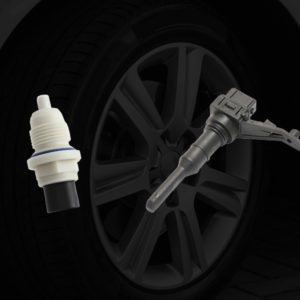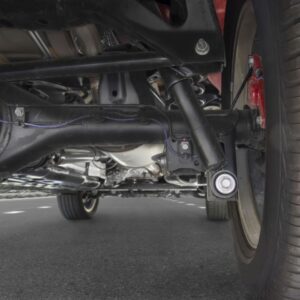Haldex is an intelligent all-wheel drive (AWD) system commonly found in vehicles from European automakers like Volkswagen, Audi, and Volvo. The technology is basically all-wheel drive on demand, closely resembling the functions of a four-wheel drive (4WD) setup.
Haldex systems are commonly integrated into vehicles that operate in front-wheel drive (FWD) mode. Although such tech can also be found in rear-wheel drive (RWD) vehicles, this is far less common.
Haldex has been around since the mid-90s, showcasing efficient designs of the all-wheel drive setup for five generations.
Originally designed by the Swedish Haldex Traction company, the technology was eventually sold to BorgWarner in 2011.
How Does Haldex AWD Work?
Active on-demand coupling (AOC) is the main component that makes up the Haldex AWD design. Positioned at the nose of the rear differential, the AOC only engages when the front wheels lose traction.
Essentially, a Haldex AWD will only operate when the system detects slippage in one of the wheels.
Haldex AWD technology is a part-time AWD system that constantly keeps the rear driveshaft engaged. However, the differential it connects to remains inactive under normal driving conditions.
When the sensors detect wheel slippage, a valve opens, allowing pressurized hydraulic fluid to reach the Haldex clutch. The same hydraulic fluid also provides power to the wheels containing the Haldex differential.
The AOC in a Haldex system has two sets of wet friction plates or clutches. One set is connected to the driveshaft, while the other is linked to the rear differential.
When both sets of plates are engaged, torque transfer can go as much as 50% rearward.
The AOC also has a bevel box, a unit mounted to the back of the transmission that rotates the transaxle’s force by up to 90 degrees, sending the component rearward through the driveshaft.
By incorporating a bevel box into the system, vehicles with a Haldex AWD retain the benefits of a transverse engine layout plus the advantages of an all-wheel drive setup.
Perks of Using Haldex Tech

Using Haldex tech comes with two main benefits一improved fuel economy and space-saving packaging.
Unlike conventional all-wheel drive systems, Haldex AWD activation is on-demand. This means that a vehicle with this tech won’t consume as much fuel as the typical AWD setup because Haldex will only work and engage all wheels when necessary.
Haldex systems are designed to be small, making them an ideal fit even for densely packed engines.
Drawbacks to Using Haldex Tech
As convenient as Haldex systems are, there are certain drawbacks to using them.
Torque split is the first one. Due to its design, a Haldex AWD system can only send up to 50% of the engine’s power to the non-dominant drive axle.
The next drawback is maintenance. Given its complexity, a Haldex setup generally requires more frequent maintenance compared to other AWD systems.
Finally, Haldex systems heavily rely on electronics. Because of this setup, a simple electrical malfunction can render the system inoperable.
Get to Know the Five Generations of Haldex Systems
Haldex systems have been around for quite some time, and the fact that they’re still used today is a testament to their high-quality development and engineering.
Haldex 1 – 90/10 Resting Torque Split
The first vehicle to use Haldex tech was the 1998 Volkswagen Golf 4Motion. Unlike modern Haldex systems, the one in this VW Golf uses a mechanical pump built into the clutch packs.
Both shafts of this early-model Haldex system rotate at similar speeds, producing little to no pressure from the mechanical pump.
As soon as the front wheels lose traction, the input shaft clutch set on the driveshaft side will spin faster than the one on the differential side.
The pistons will then work back and forth to create hydraulic pressure, eventually locking the clutches.
Haldex 2 – 95/5 Resting Torque Split
The second generation of the Haldex system was introduced in 2002, which features an electronically controlled solenoid pack.
The solenoid-controlled throttle valve replaced the linear throttle valve, and a pressure sensor was integrated into the system for closed-loop pressure control.
Solenoid operation and pressure sensor data were controlled via a differential electronic module or electronic control module, resulting in a more accurate and variable Haldex system.
Because solenoids replaced mechanical valves, the system also shrank in size, becoming more compact than the first-generation Haldex.
Haldex 3 – 95/5 Resting Torque Split
For the third-generation Haldex, a check valve was introduced. This addition resulted in immediate pressurization and instant torque transfer.
Also known as the PreX AWD, the third-generation Haldex system also featured a bigger feeder pump than those from the previous generations.
The PreX AWD also replaced the mechanical pump with an electric one.
Haldex 4 – 100/0 Resting Torque Split
Fourth-generation Haldex systems were introduced in 2007. The systems now featured single electric pumps for pressure generation, which were controlled by the ECU.
Pressure from the single electric pump could be altered, depending on the readings from the system’s sensors.
A pressure-reducing valve also replaced the proportional throttle valve for the fourth generation. At the same time, a hydraulic accumulator was introduced.
Haldex 5 – 100/0 Resting Torque Split
BorgWarner took over for Haldex Traction in developing the AWD system. In its first year, BorgWarner simplified the AOC and introduced the Centrifugal Electro-Hydraulic Actuator.
The actuator combined a pump and overflow valve in one unit, eliminating the need for a separate accumulator, solenoid, and fluid filter.
Any information provided on this Website is for informational purposes only and is not intended to replace consultation with a professional mechanic. The accuracy and timeliness of the information may change from the time of publication.



















